Strategic Management Coursework: Analyzing HFL's Market Position
VerifiedAdded on 2023/06/11
|29
|5923
|342
Report
AI Summary
This assignment provides a comprehensive strategic analysis of High Flyers Limited (HFL), a UK-based company specializing in handmade gymnastics wear. The analysis includes a PEST analysis, SWOT analysis, and Porter's Five Forces framework to assess the external and internal factors influencing HFL's business. The report identifies key issues such as declining profit margins, increasing VAT levels, and competition from lower-quality alternatives. Additionally, the document discusses HFL's strategic position, key challenges, and opportunities for growth, including new market demands and potential expansion into South East Asia. The analysis culminates in strategic recommendations aimed at enhancing HFL's competitive advantage and achieving sustainable business growth. Also included is a coursework on change management process, resistance to change and reasons for resistance to change.
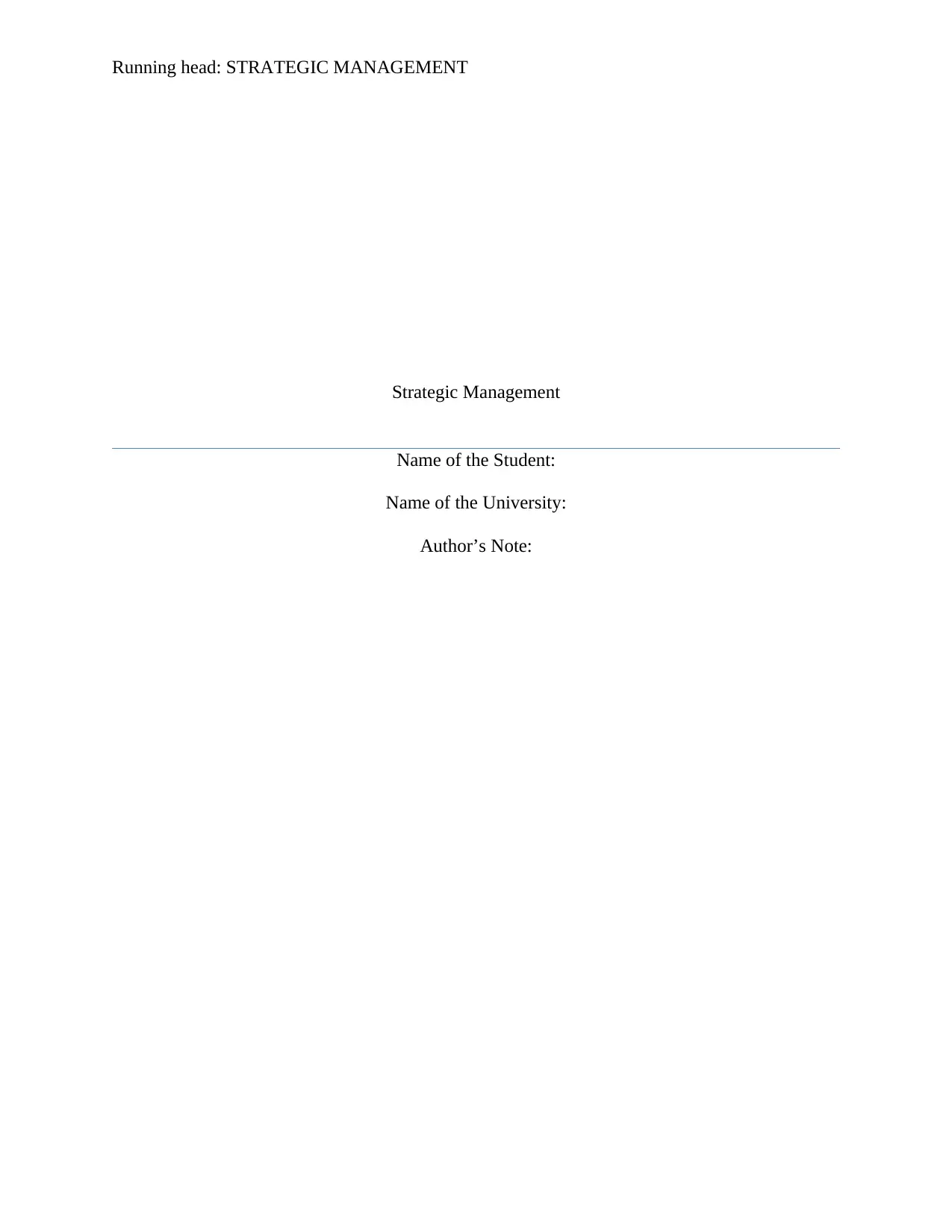
Running head: STRATEGIC MANAGEMENT
Strategic Management
Name of the Student:
Name of the University:
Author’s Note:
Strategic Management
Name of the Student:
Name of the University:
Author’s Note:
Paraphrase This Document
Need a fresh take? Get an instant paraphrase of this document with our AI Paraphraser
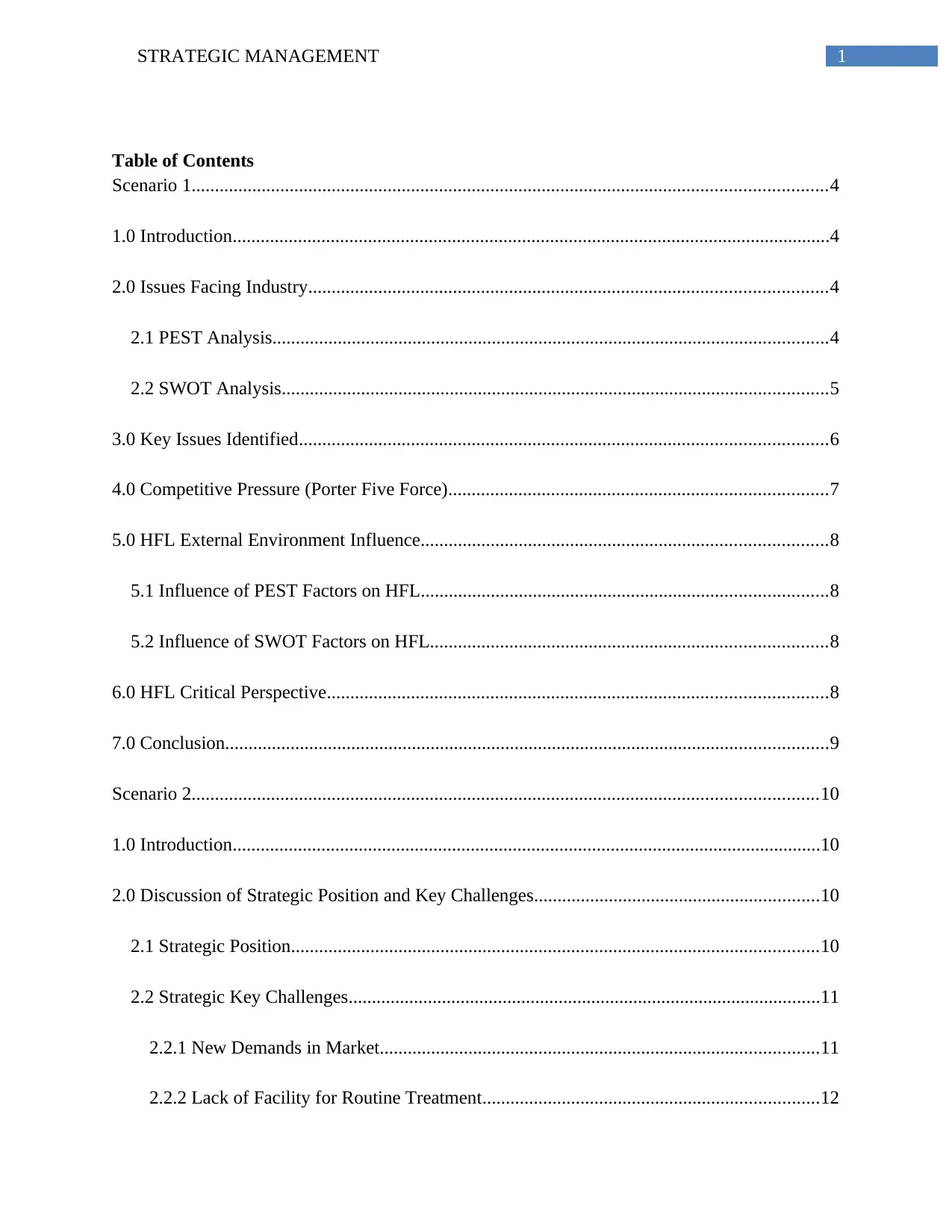
1STRATEGIC MANAGEMENT
Table of Contents
Scenario 1........................................................................................................................................4
1.0 Introduction................................................................................................................................4
2.0 Issues Facing Industry...............................................................................................................4
2.1 PEST Analysis.......................................................................................................................4
2.2 SWOT Analysis.....................................................................................................................5
3.0 Key Issues Identified.................................................................................................................6
4.0 Competitive Pressure (Porter Five Force).................................................................................7
5.0 HFL External Environment Influence.......................................................................................8
5.1 Influence of PEST Factors on HFL.......................................................................................8
5.2 Influence of SWOT Factors on HFL.....................................................................................8
6.0 HFL Critical Perspective...........................................................................................................8
7.0 Conclusion.................................................................................................................................9
Scenario 2......................................................................................................................................10
1.0 Introduction..............................................................................................................................10
2.0 Discussion of Strategic Position and Key Challenges.............................................................10
2.1 Strategic Position.................................................................................................................10
2.2 Strategic Key Challenges.....................................................................................................11
2.2.1 New Demands in Market..............................................................................................11
2.2.2 Lack of Facility for Routine Treatment........................................................................12
Table of Contents
Scenario 1........................................................................................................................................4
1.0 Introduction................................................................................................................................4
2.0 Issues Facing Industry...............................................................................................................4
2.1 PEST Analysis.......................................................................................................................4
2.2 SWOT Analysis.....................................................................................................................5
3.0 Key Issues Identified.................................................................................................................6
4.0 Competitive Pressure (Porter Five Force).................................................................................7
5.0 HFL External Environment Influence.......................................................................................8
5.1 Influence of PEST Factors on HFL.......................................................................................8
5.2 Influence of SWOT Factors on HFL.....................................................................................8
6.0 HFL Critical Perspective...........................................................................................................8
7.0 Conclusion.................................................................................................................................9
Scenario 2......................................................................................................................................10
1.0 Introduction..............................................................................................................................10
2.0 Discussion of Strategic Position and Key Challenges.............................................................10
2.1 Strategic Position.................................................................................................................10
2.2 Strategic Key Challenges.....................................................................................................11
2.2.1 New Demands in Market..............................................................................................11
2.2.2 Lack of Facility for Routine Treatment........................................................................12
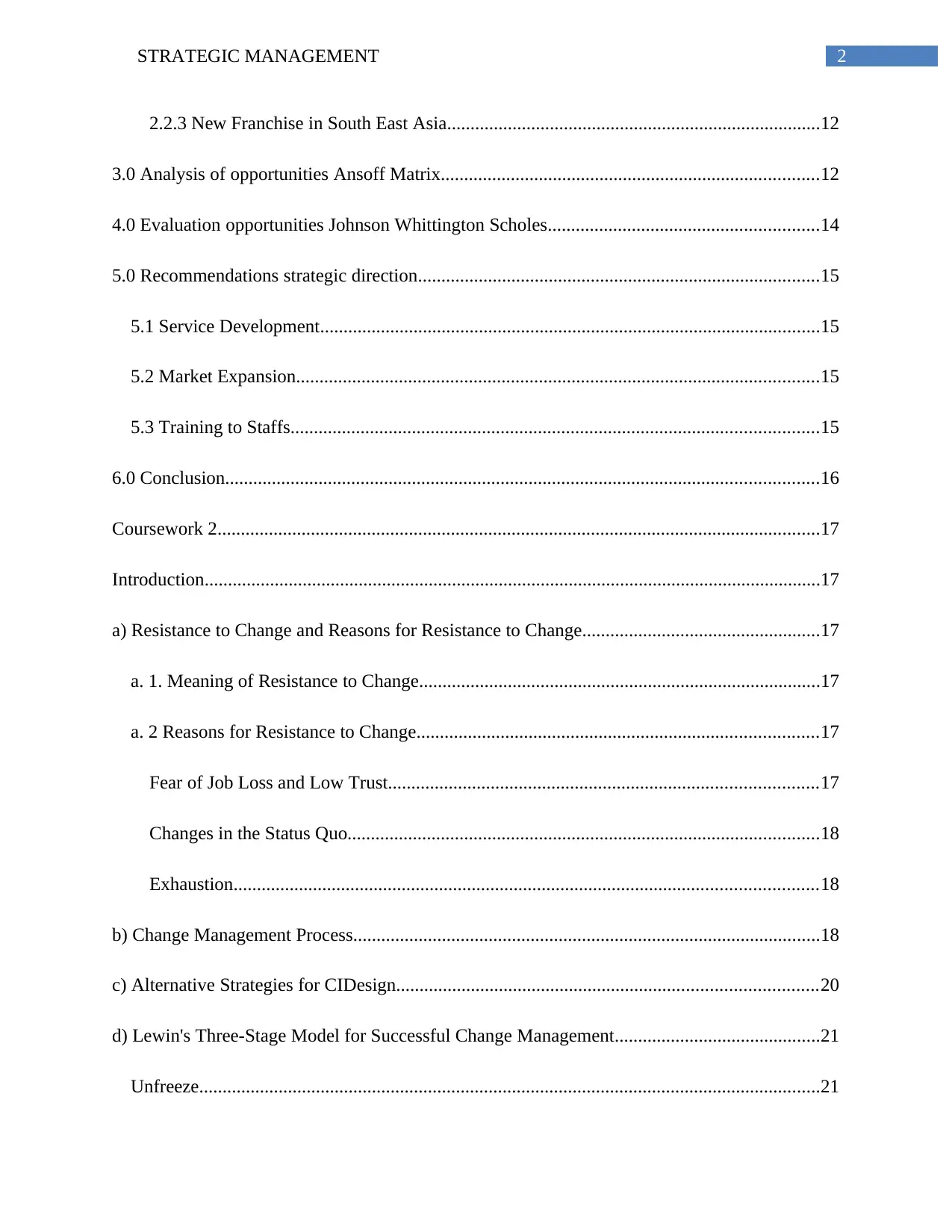
2STRATEGIC MANAGEMENT
2.2.3 New Franchise in South East Asia................................................................................12
3.0 Analysis of opportunities Ansoff Matrix.................................................................................12
4.0 Evaluation opportunities Johnson Whittington Scholes..........................................................14
5.0 Recommendations strategic direction......................................................................................15
5.1 Service Development...........................................................................................................15
5.2 Market Expansion................................................................................................................15
5.3 Training to Staffs.................................................................................................................15
6.0 Conclusion...............................................................................................................................16
Coursework 2.................................................................................................................................17
Introduction....................................................................................................................................17
a) Resistance to Change and Reasons for Resistance to Change...................................................17
a. 1. Meaning of Resistance to Change......................................................................................17
a. 2 Reasons for Resistance to Change......................................................................................17
Fear of Job Loss and Low Trust............................................................................................17
Changes in the Status Quo.....................................................................................................18
Exhaustion.............................................................................................................................18
b) Change Management Process....................................................................................................18
c) Alternative Strategies for CIDesign..........................................................................................20
d) Lewin's Three-Stage Model for Successful Change Management............................................21
Unfreeze.....................................................................................................................................21
2.2.3 New Franchise in South East Asia................................................................................12
3.0 Analysis of opportunities Ansoff Matrix.................................................................................12
4.0 Evaluation opportunities Johnson Whittington Scholes..........................................................14
5.0 Recommendations strategic direction......................................................................................15
5.1 Service Development...........................................................................................................15
5.2 Market Expansion................................................................................................................15
5.3 Training to Staffs.................................................................................................................15
6.0 Conclusion...............................................................................................................................16
Coursework 2.................................................................................................................................17
Introduction....................................................................................................................................17
a) Resistance to Change and Reasons for Resistance to Change...................................................17
a. 1. Meaning of Resistance to Change......................................................................................17
a. 2 Reasons for Resistance to Change......................................................................................17
Fear of Job Loss and Low Trust............................................................................................17
Changes in the Status Quo.....................................................................................................18
Exhaustion.............................................................................................................................18
b) Change Management Process....................................................................................................18
c) Alternative Strategies for CIDesign..........................................................................................20
d) Lewin's Three-Stage Model for Successful Change Management............................................21
Unfreeze.....................................................................................................................................21
⊘ This is a preview!⊘
Do you want full access?
Subscribe today to unlock all pages.

Trusted by 1+ million students worldwide
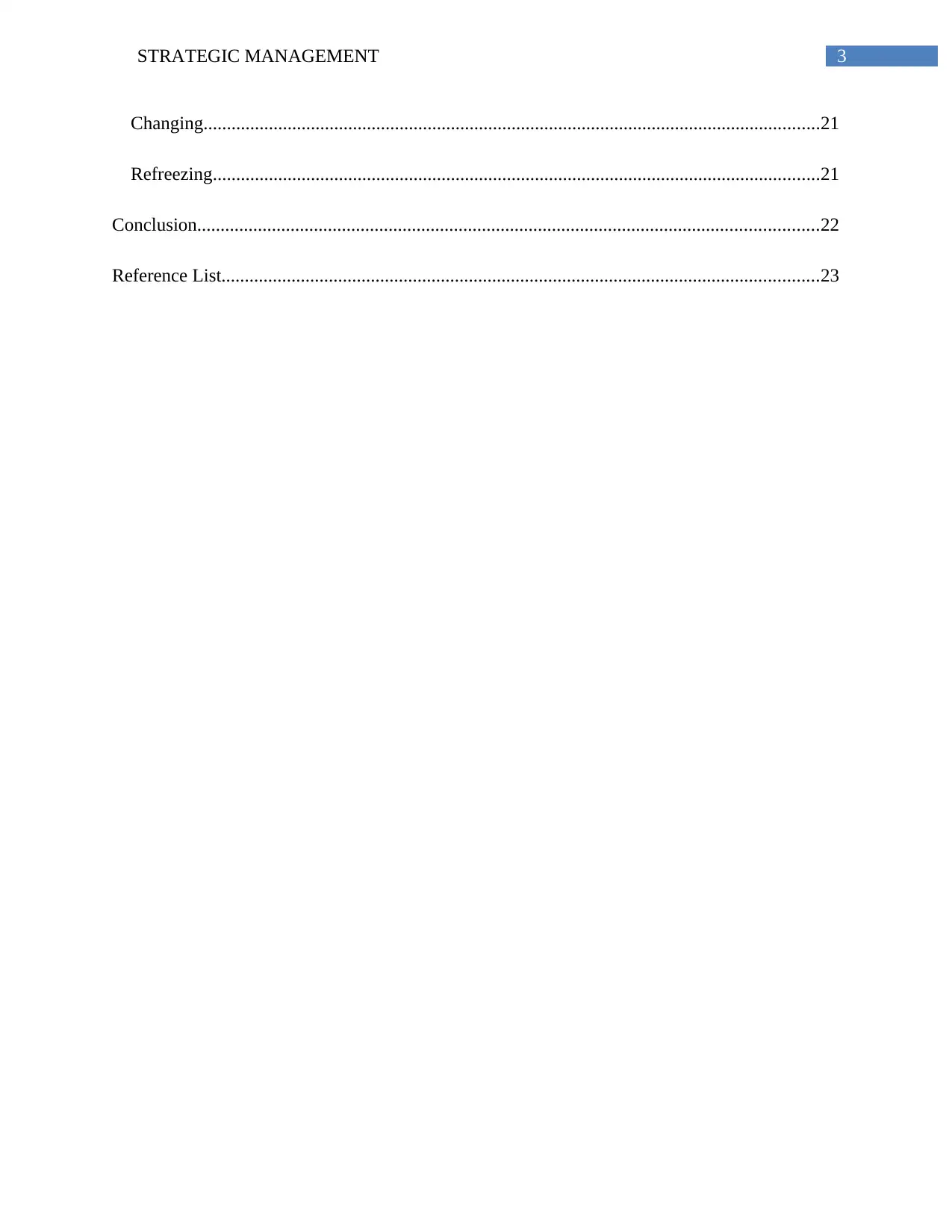
3STRATEGIC MANAGEMENT
Changing....................................................................................................................................21
Refreezing..................................................................................................................................21
Conclusion.....................................................................................................................................22
Reference List................................................................................................................................23
Changing....................................................................................................................................21
Refreezing..................................................................................................................................21
Conclusion.....................................................................................................................................22
Reference List................................................................................................................................23
Paraphrase This Document
Need a fresh take? Get an instant paraphrase of this document with our AI Paraphraser
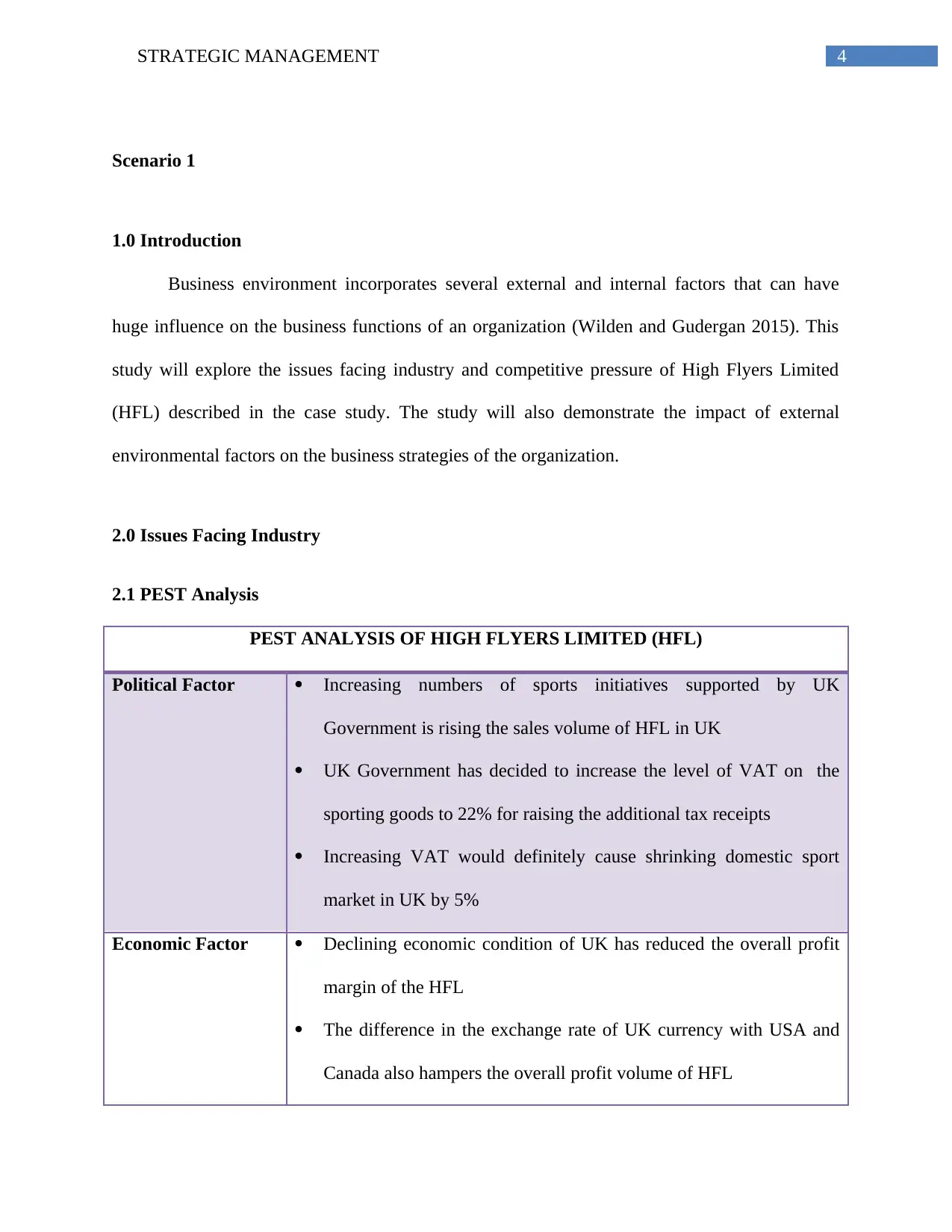
4STRATEGIC MANAGEMENT
Scenario 1
1.0 Introduction
Business environment incorporates several external and internal factors that can have
huge influence on the business functions of an organization (Wilden and Gudergan 2015). This
study will explore the issues facing industry and competitive pressure of High Flyers Limited
(HFL) described in the case study. The study will also demonstrate the impact of external
environmental factors on the business strategies of the organization.
2.0 Issues Facing Industry
2.1 PEST Analysis
PEST ANALYSIS OF HIGH FLYERS LIMITED (HFL)
Political Factor Increasing numbers of sports initiatives supported by UK
Government is rising the sales volume of HFL in UK
UK Government has decided to increase the level of VAT on the
sporting goods to 22% for raising the additional tax receipts
Increasing VAT would definitely cause shrinking domestic sport
market in UK by 5%
Economic Factor Declining economic condition of UK has reduced the overall profit
margin of the HFL
The difference in the exchange rate of UK currency with USA and
Canada also hampers the overall profit volume of HFL
Scenario 1
1.0 Introduction
Business environment incorporates several external and internal factors that can have
huge influence on the business functions of an organization (Wilden and Gudergan 2015). This
study will explore the issues facing industry and competitive pressure of High Flyers Limited
(HFL) described in the case study. The study will also demonstrate the impact of external
environmental factors on the business strategies of the organization.
2.0 Issues Facing Industry
2.1 PEST Analysis
PEST ANALYSIS OF HIGH FLYERS LIMITED (HFL)
Political Factor Increasing numbers of sports initiatives supported by UK
Government is rising the sales volume of HFL in UK
UK Government has decided to increase the level of VAT on the
sporting goods to 22% for raising the additional tax receipts
Increasing VAT would definitely cause shrinking domestic sport
market in UK by 5%
Economic Factor Declining economic condition of UK has reduced the overall profit
margin of the HFL
The difference in the exchange rate of UK currency with USA and
Canada also hampers the overall profit volume of HFL
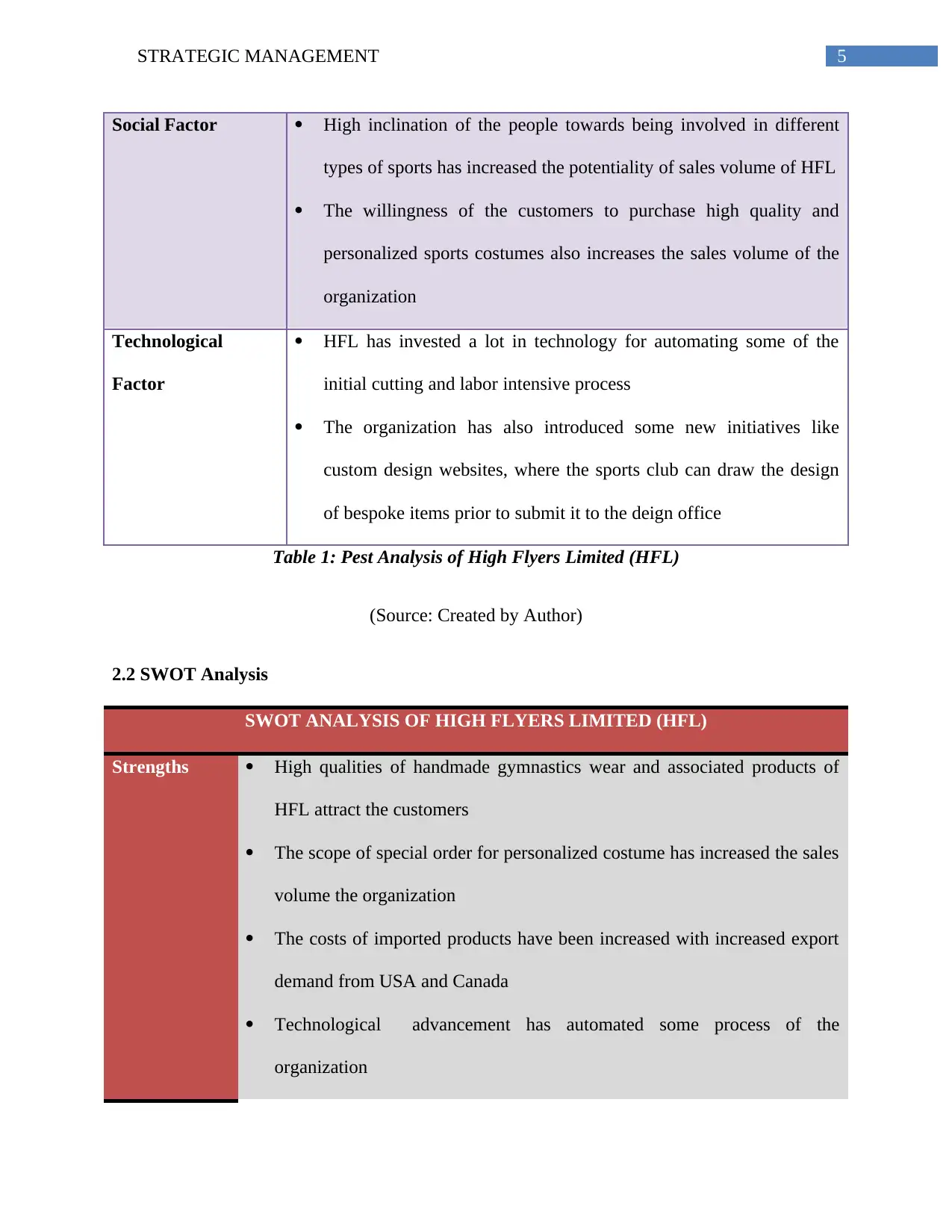
5STRATEGIC MANAGEMENT
Social Factor High inclination of the people towards being involved in different
types of sports has increased the potentiality of sales volume of HFL
The willingness of the customers to purchase high quality and
personalized sports costumes also increases the sales volume of the
organization
Technological
Factor
HFL has invested a lot in technology for automating some of the
initial cutting and labor intensive process
The organization has also introduced some new initiatives like
custom design websites, where the sports club can draw the design
of bespoke items prior to submit it to the deign office
Table 1: Pest Analysis of High Flyers Limited (HFL)
(Source: Created by Author)
2.2 SWOT Analysis
SWOT ANALYSIS OF HIGH FLYERS LIMITED (HFL)
Strengths High qualities of handmade gymnastics wear and associated products of
HFL attract the customers
The scope of special order for personalized costume has increased the sales
volume the organization
The costs of imported products have been increased with increased export
demand from USA and Canada
Technological advancement has automated some process of the
organization
Social Factor High inclination of the people towards being involved in different
types of sports has increased the potentiality of sales volume of HFL
The willingness of the customers to purchase high quality and
personalized sports costumes also increases the sales volume of the
organization
Technological
Factor
HFL has invested a lot in technology for automating some of the
initial cutting and labor intensive process
The organization has also introduced some new initiatives like
custom design websites, where the sports club can draw the design
of bespoke items prior to submit it to the deign office
Table 1: Pest Analysis of High Flyers Limited (HFL)
(Source: Created by Author)
2.2 SWOT Analysis
SWOT ANALYSIS OF HIGH FLYERS LIMITED (HFL)
Strengths High qualities of handmade gymnastics wear and associated products of
HFL attract the customers
The scope of special order for personalized costume has increased the sales
volume the organization
The costs of imported products have been increased with increased export
demand from USA and Canada
Technological advancement has automated some process of the
organization
⊘ This is a preview!⊘
Do you want full access?
Subscribe today to unlock all pages.

Trusted by 1+ million students worldwide
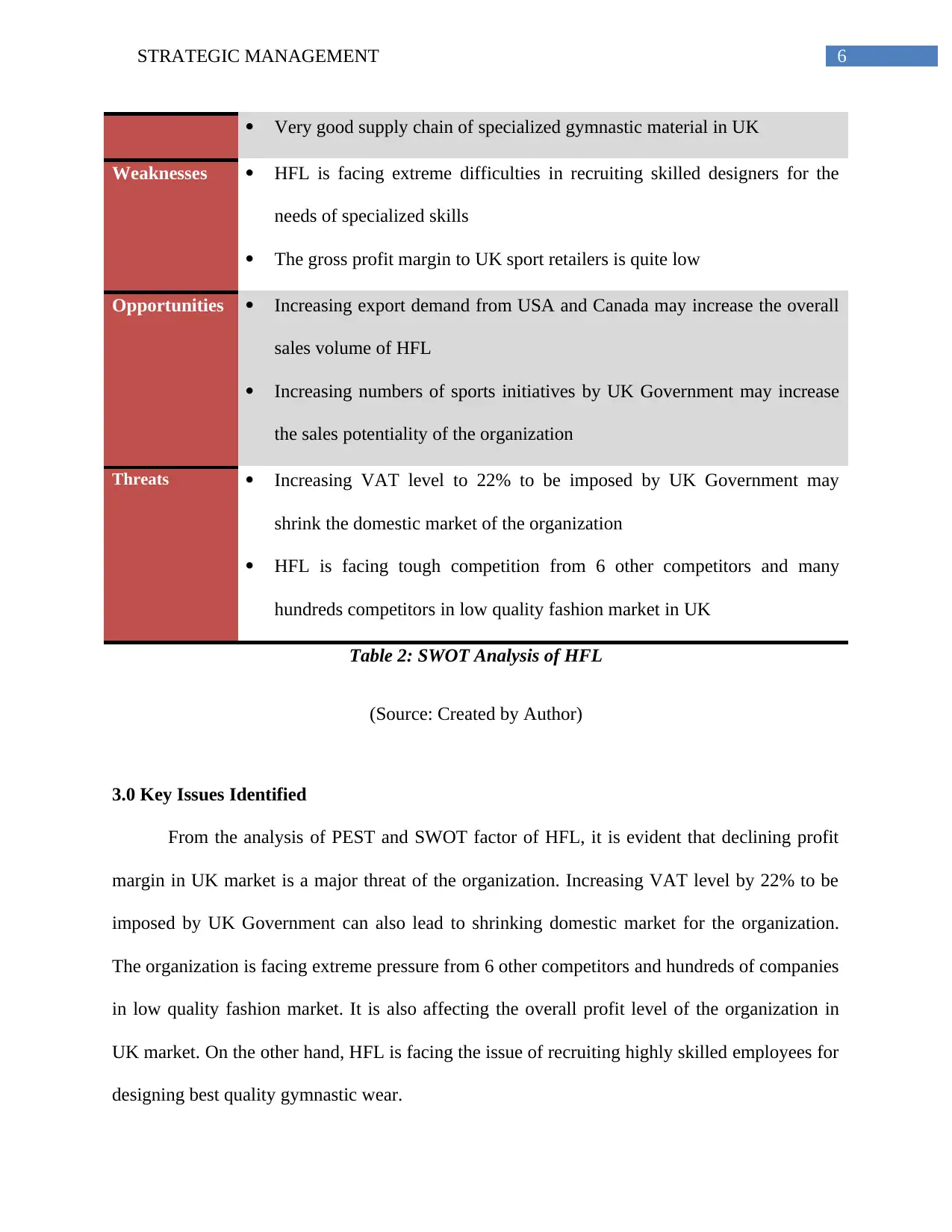
6STRATEGIC MANAGEMENT
Very good supply chain of specialized gymnastic material in UK
Weaknesses HFL is facing extreme difficulties in recruiting skilled designers for the
needs of specialized skills
The gross profit margin to UK sport retailers is quite low
Opportunities Increasing export demand from USA and Canada may increase the overall
sales volume of HFL
Increasing numbers of sports initiatives by UK Government may increase
the sales potentiality of the organization
Threats Increasing VAT level to 22% to be imposed by UK Government may
shrink the domestic market of the organization
HFL is facing tough competition from 6 other competitors and many
hundreds competitors in low quality fashion market in UK
Table 2: SWOT Analysis of HFL
(Source: Created by Author)
3.0 Key Issues Identified
From the analysis of PEST and SWOT factor of HFL, it is evident that declining profit
margin in UK market is a major threat of the organization. Increasing VAT level by 22% to be
imposed by UK Government can also lead to shrinking domestic market for the organization.
The organization is facing extreme pressure from 6 other competitors and hundreds of companies
in low quality fashion market. It is also affecting the overall profit level of the organization in
UK market. On the other hand, HFL is facing the issue of recruiting highly skilled employees for
designing best quality gymnastic wear.
Very good supply chain of specialized gymnastic material in UK
Weaknesses HFL is facing extreme difficulties in recruiting skilled designers for the
needs of specialized skills
The gross profit margin to UK sport retailers is quite low
Opportunities Increasing export demand from USA and Canada may increase the overall
sales volume of HFL
Increasing numbers of sports initiatives by UK Government may increase
the sales potentiality of the organization
Threats Increasing VAT level to 22% to be imposed by UK Government may
shrink the domestic market of the organization
HFL is facing tough competition from 6 other competitors and many
hundreds competitors in low quality fashion market in UK
Table 2: SWOT Analysis of HFL
(Source: Created by Author)
3.0 Key Issues Identified
From the analysis of PEST and SWOT factor of HFL, it is evident that declining profit
margin in UK market is a major threat of the organization. Increasing VAT level by 22% to be
imposed by UK Government can also lead to shrinking domestic market for the organization.
The organization is facing extreme pressure from 6 other competitors and hundreds of companies
in low quality fashion market. It is also affecting the overall profit level of the organization in
UK market. On the other hand, HFL is facing the issue of recruiting highly skilled employees for
designing best quality gymnastic wear.
Paraphrase This Document
Need a fresh take? Get an instant paraphrase of this document with our AI Paraphraser
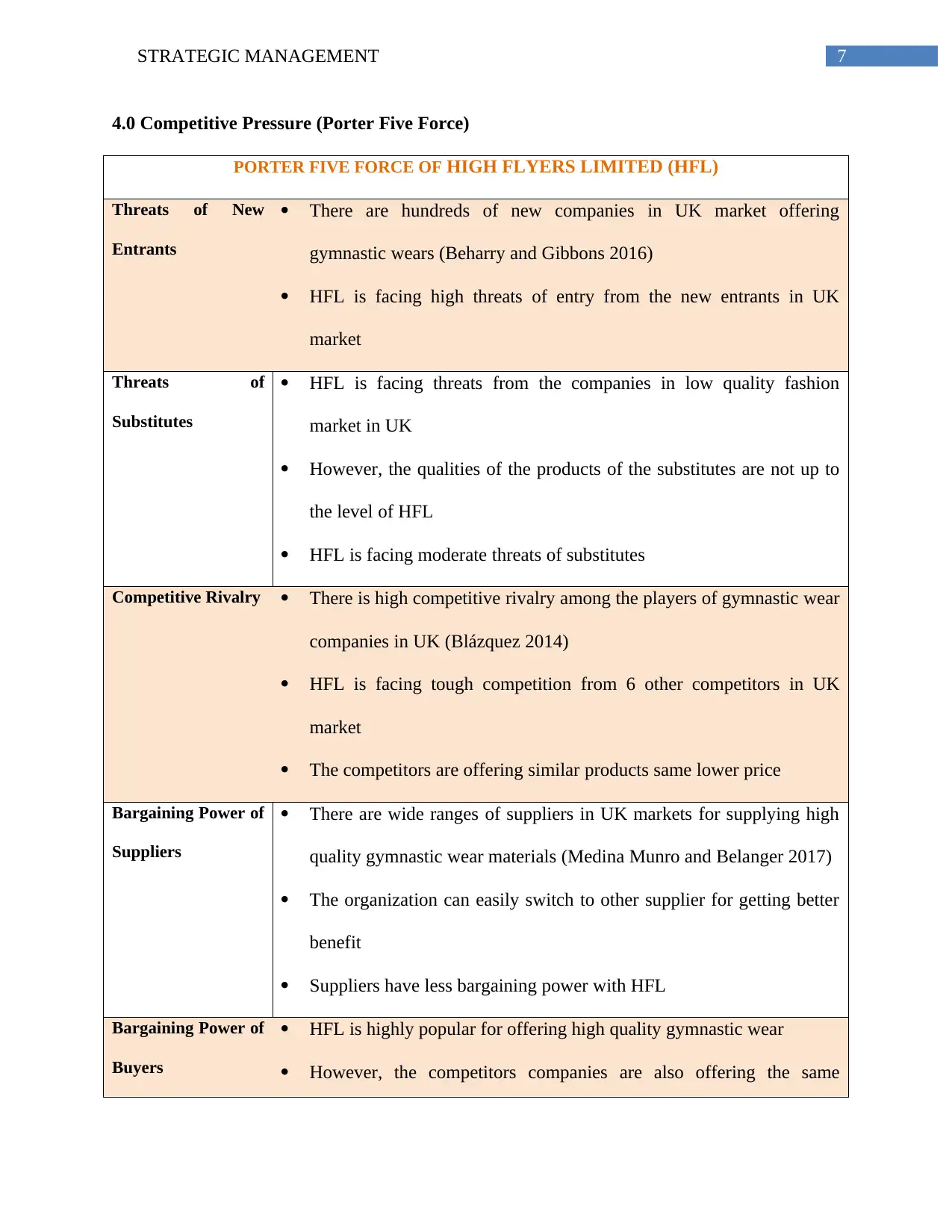
7STRATEGIC MANAGEMENT
4.0 Competitive Pressure (Porter Five Force)
PORTER FIVE FORCE OF HIGH FLYERS LIMITED (HFL)
Threats of New
Entrants
There are hundreds of new companies in UK market offering
gymnastic wears (Beharry and Gibbons 2016)
HFL is facing high threats of entry from the new entrants in UK
market
Threats of
Substitutes
HFL is facing threats from the companies in low quality fashion
market in UK
However, the qualities of the products of the substitutes are not up to
the level of HFL
HFL is facing moderate threats of substitutes
Competitive Rivalry There is high competitive rivalry among the players of gymnastic wear
companies in UK (Blázquez 2014)
HFL is facing tough competition from 6 other competitors in UK
market
The competitors are offering similar products same lower price
Bargaining Power of
Suppliers
There are wide ranges of suppliers in UK markets for supplying high
quality gymnastic wear materials (Medina Munro and Belanger 2017)
The organization can easily switch to other supplier for getting better
benefit
Suppliers have less bargaining power with HFL
Bargaining Power of
Buyers
HFL is highly popular for offering high quality gymnastic wear
However, the competitors companies are also offering the same
4.0 Competitive Pressure (Porter Five Force)
PORTER FIVE FORCE OF HIGH FLYERS LIMITED (HFL)
Threats of New
Entrants
There are hundreds of new companies in UK market offering
gymnastic wears (Beharry and Gibbons 2016)
HFL is facing high threats of entry from the new entrants in UK
market
Threats of
Substitutes
HFL is facing threats from the companies in low quality fashion
market in UK
However, the qualities of the products of the substitutes are not up to
the level of HFL
HFL is facing moderate threats of substitutes
Competitive Rivalry There is high competitive rivalry among the players of gymnastic wear
companies in UK (Blázquez 2014)
HFL is facing tough competition from 6 other competitors in UK
market
The competitors are offering similar products same lower price
Bargaining Power of
Suppliers
There are wide ranges of suppliers in UK markets for supplying high
quality gymnastic wear materials (Medina Munro and Belanger 2017)
The organization can easily switch to other supplier for getting better
benefit
Suppliers have less bargaining power with HFL
Bargaining Power of
Buyers
HFL is highly popular for offering high quality gymnastic wear
However, the competitors companies are also offering the same
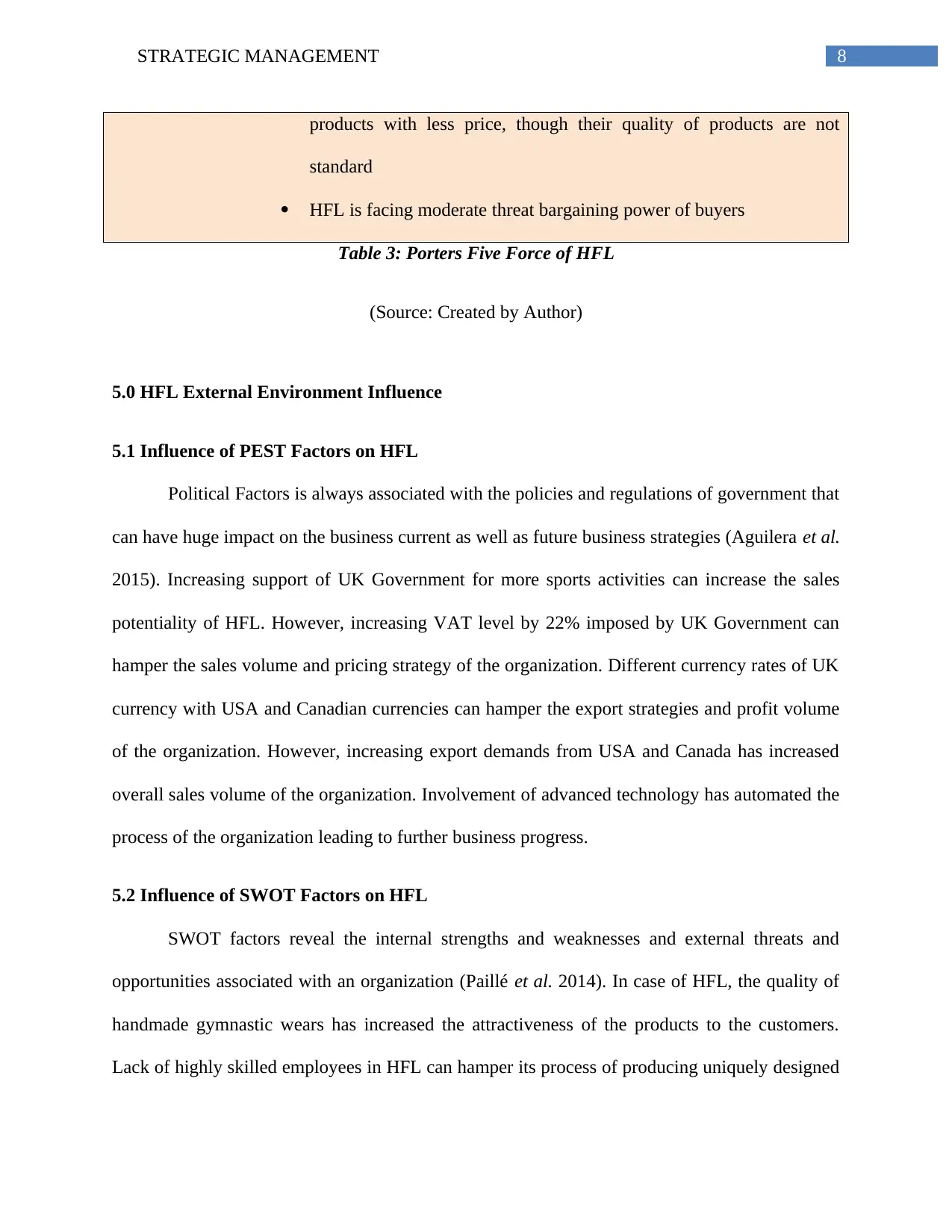
8STRATEGIC MANAGEMENT
products with less price, though their quality of products are not
standard
HFL is facing moderate threat bargaining power of buyers
Table 3: Porters Five Force of HFL
(Source: Created by Author)
5.0 HFL External Environment Influence
5.1 Influence of PEST Factors on HFL
Political Factors is always associated with the policies and regulations of government that
can have huge impact on the business current as well as future business strategies (Aguilera et al.
2015). Increasing support of UK Government for more sports activities can increase the sales
potentiality of HFL. However, increasing VAT level by 22% imposed by UK Government can
hamper the sales volume and pricing strategy of the organization. Different currency rates of UK
currency with USA and Canadian currencies can hamper the export strategies and profit volume
of the organization. However, increasing export demands from USA and Canada has increased
overall sales volume of the organization. Involvement of advanced technology has automated the
process of the organization leading to further business progress.
5.2 Influence of SWOT Factors on HFL
SWOT factors reveal the internal strengths and weaknesses and external threats and
opportunities associated with an organization (Paillé et al. 2014). In case of HFL, the quality of
handmade gymnastic wears has increased the attractiveness of the products to the customers.
Lack of highly skilled employees in HFL can hamper its process of producing uniquely designed
products with less price, though their quality of products are not
standard
HFL is facing moderate threat bargaining power of buyers
Table 3: Porters Five Force of HFL
(Source: Created by Author)
5.0 HFL External Environment Influence
5.1 Influence of PEST Factors on HFL
Political Factors is always associated with the policies and regulations of government that
can have huge impact on the business current as well as future business strategies (Aguilera et al.
2015). Increasing support of UK Government for more sports activities can increase the sales
potentiality of HFL. However, increasing VAT level by 22% imposed by UK Government can
hamper the sales volume and pricing strategy of the organization. Different currency rates of UK
currency with USA and Canadian currencies can hamper the export strategies and profit volume
of the organization. However, increasing export demands from USA and Canada has increased
overall sales volume of the organization. Involvement of advanced technology has automated the
process of the organization leading to further business progress.
5.2 Influence of SWOT Factors on HFL
SWOT factors reveal the internal strengths and weaknesses and external threats and
opportunities associated with an organization (Paillé et al. 2014). In case of HFL, the quality of
handmade gymnastic wears has increased the attractiveness of the products to the customers.
Lack of highly skilled employees in HFL can hamper its process of producing uniquely designed
⊘ This is a preview!⊘
Do you want full access?
Subscribe today to unlock all pages.

Trusted by 1+ million students worldwide
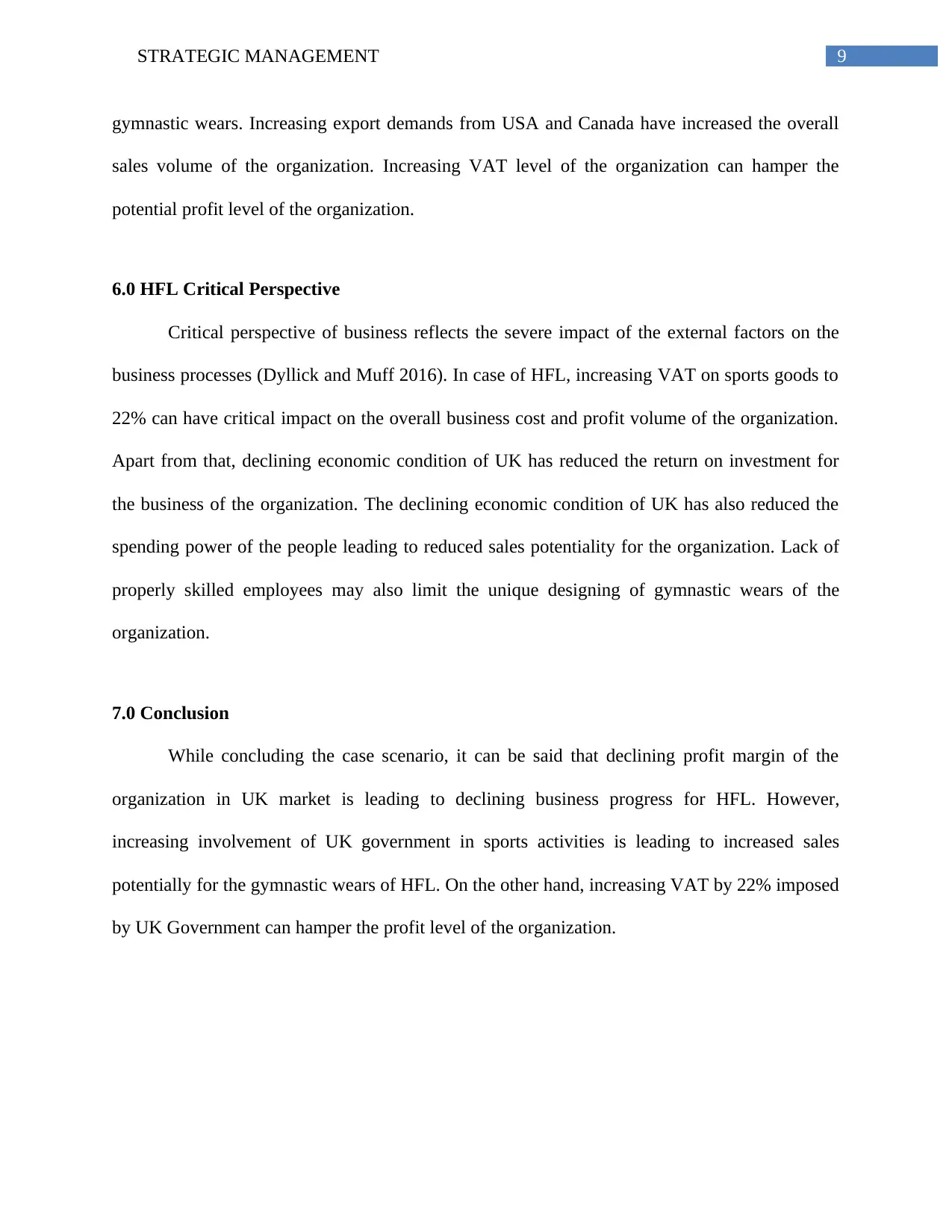
9STRATEGIC MANAGEMENT
gymnastic wears. Increasing export demands from USA and Canada have increased the overall
sales volume of the organization. Increasing VAT level of the organization can hamper the
potential profit level of the organization.
6.0 HFL Critical Perspective
Critical perspective of business reflects the severe impact of the external factors on the
business processes (Dyllick and Muff 2016). In case of HFL, increasing VAT on sports goods to
22% can have critical impact on the overall business cost and profit volume of the organization.
Apart from that, declining economic condition of UK has reduced the return on investment for
the business of the organization. The declining economic condition of UK has also reduced the
spending power of the people leading to reduced sales potentiality for the organization. Lack of
properly skilled employees may also limit the unique designing of gymnastic wears of the
organization.
7.0 Conclusion
While concluding the case scenario, it can be said that declining profit margin of the
organization in UK market is leading to declining business progress for HFL. However,
increasing involvement of UK government in sports activities is leading to increased sales
potentially for the gymnastic wears of HFL. On the other hand, increasing VAT by 22% imposed
by UK Government can hamper the profit level of the organization.
gymnastic wears. Increasing export demands from USA and Canada have increased the overall
sales volume of the organization. Increasing VAT level of the organization can hamper the
potential profit level of the organization.
6.0 HFL Critical Perspective
Critical perspective of business reflects the severe impact of the external factors on the
business processes (Dyllick and Muff 2016). In case of HFL, increasing VAT on sports goods to
22% can have critical impact on the overall business cost and profit volume of the organization.
Apart from that, declining economic condition of UK has reduced the return on investment for
the business of the organization. The declining economic condition of UK has also reduced the
spending power of the people leading to reduced sales potentiality for the organization. Lack of
properly skilled employees may also limit the unique designing of gymnastic wears of the
organization.
7.0 Conclusion
While concluding the case scenario, it can be said that declining profit margin of the
organization in UK market is leading to declining business progress for HFL. However,
increasing involvement of UK government in sports activities is leading to increased sales
potentially for the gymnastic wears of HFL. On the other hand, increasing VAT by 22% imposed
by UK Government can hamper the profit level of the organization.
Paraphrase This Document
Need a fresh take? Get an instant paraphrase of this document with our AI Paraphraser
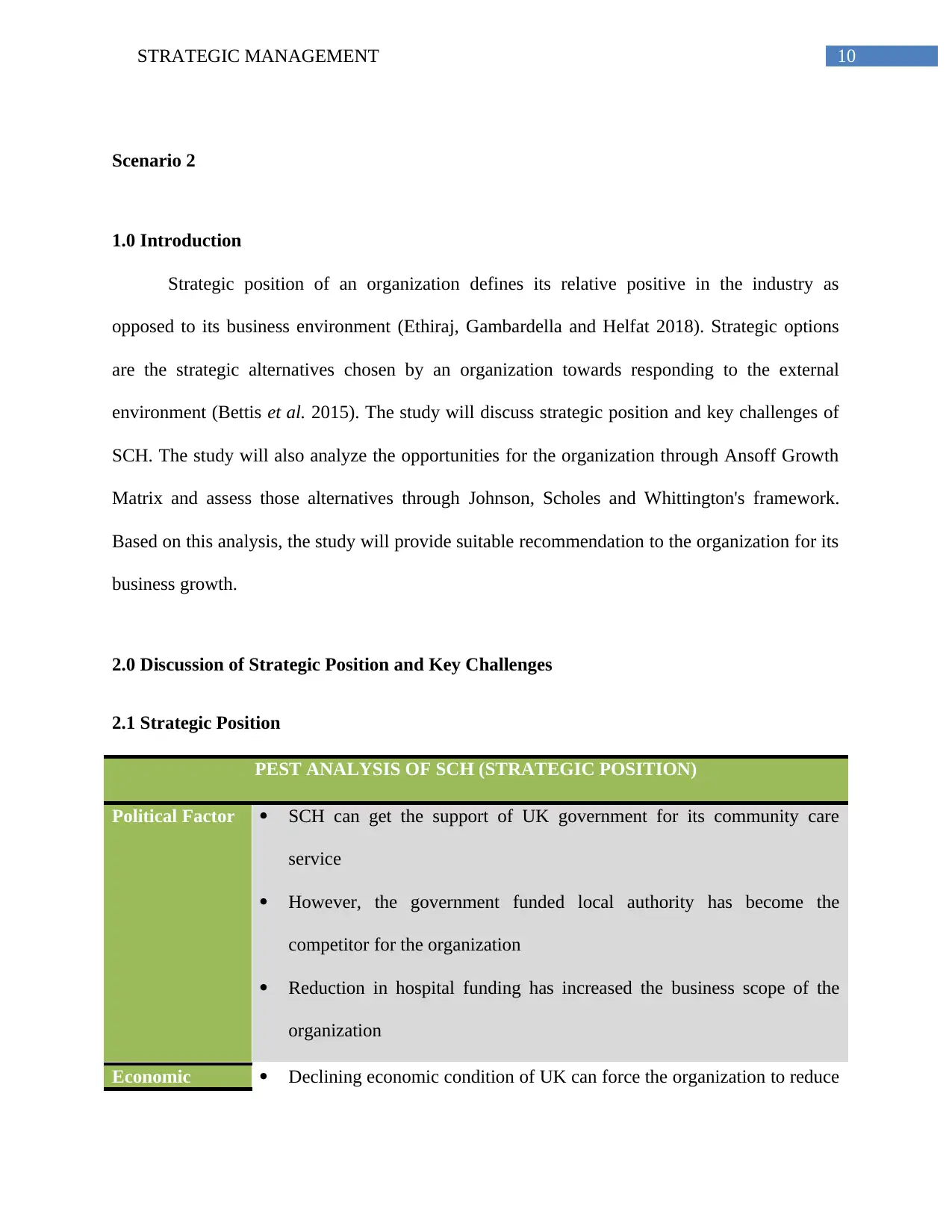
10STRATEGIC MANAGEMENT
Scenario 2
1.0 Introduction
Strategic position of an organization defines its relative positive in the industry as
opposed to its business environment (Ethiraj, Gambardella and Helfat 2018). Strategic options
are the strategic alternatives chosen by an organization towards responding to the external
environment (Bettis et al. 2015). The study will discuss strategic position and key challenges of
SCH. The study will also analyze the opportunities for the organization through Ansoff Growth
Matrix and assess those alternatives through Johnson, Scholes and Whittington's framework.
Based on this analysis, the study will provide suitable recommendation to the organization for its
business growth.
2.0 Discussion of Strategic Position and Key Challenges
2.1 Strategic Position
PEST ANALYSIS OF SCH (STRATEGIC POSITION)
Political Factor SCH can get the support of UK government for its community care
service
However, the government funded local authority has become the
competitor for the organization
Reduction in hospital funding has increased the business scope of the
organization
Economic Declining economic condition of UK can force the organization to reduce
Scenario 2
1.0 Introduction
Strategic position of an organization defines its relative positive in the industry as
opposed to its business environment (Ethiraj, Gambardella and Helfat 2018). Strategic options
are the strategic alternatives chosen by an organization towards responding to the external
environment (Bettis et al. 2015). The study will discuss strategic position and key challenges of
SCH. The study will also analyze the opportunities for the organization through Ansoff Growth
Matrix and assess those alternatives through Johnson, Scholes and Whittington's framework.
Based on this analysis, the study will provide suitable recommendation to the organization for its
business growth.
2.0 Discussion of Strategic Position and Key Challenges
2.1 Strategic Position
PEST ANALYSIS OF SCH (STRATEGIC POSITION)
Political Factor SCH can get the support of UK government for its community care
service
However, the government funded local authority has become the
competitor for the organization
Reduction in hospital funding has increased the business scope of the
organization
Economic Declining economic condition of UK can force the organization to reduce
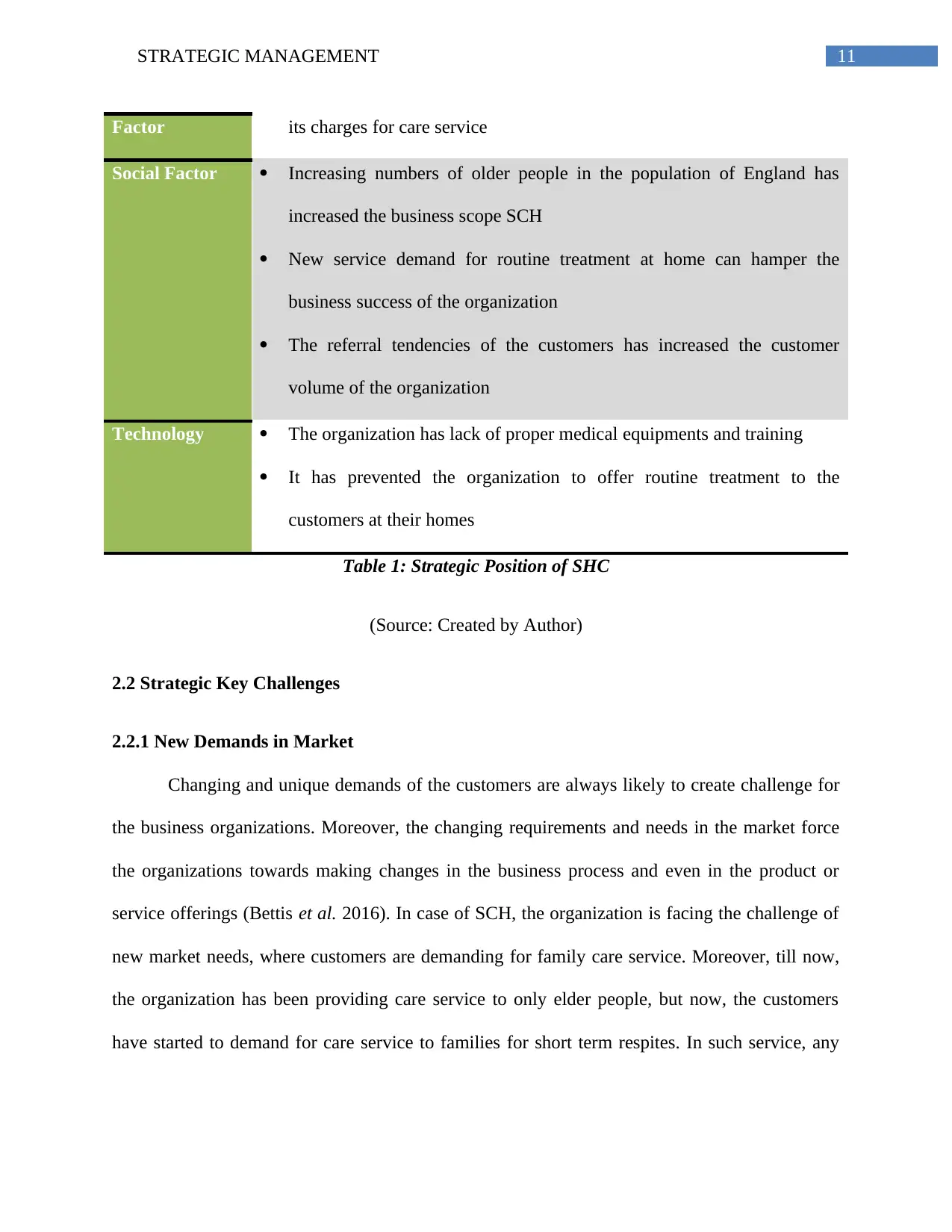
11STRATEGIC MANAGEMENT
Factor its charges for care service
Social Factor Increasing numbers of older people in the population of England has
increased the business scope SCH
New service demand for routine treatment at home can hamper the
business success of the organization
The referral tendencies of the customers has increased the customer
volume of the organization
Technology The organization has lack of proper medical equipments and training
It has prevented the organization to offer routine treatment to the
customers at their homes
Table 1: Strategic Position of SHC
(Source: Created by Author)
2.2 Strategic Key Challenges
2.2.1 New Demands in Market
Changing and unique demands of the customers are always likely to create challenge for
the business organizations. Moreover, the changing requirements and needs in the market force
the organizations towards making changes in the business process and even in the product or
service offerings (Bettis et al. 2016). In case of SCH, the organization is facing the challenge of
new market needs, where customers are demanding for family care service. Moreover, till now,
the organization has been providing care service to only elder people, but now, the customers
have started to demand for care service to families for short term respites. In such service, any
Factor its charges for care service
Social Factor Increasing numbers of older people in the population of England has
increased the business scope SCH
New service demand for routine treatment at home can hamper the
business success of the organization
The referral tendencies of the customers has increased the customer
volume of the organization
Technology The organization has lack of proper medical equipments and training
It has prevented the organization to offer routine treatment to the
customers at their homes
Table 1: Strategic Position of SHC
(Source: Created by Author)
2.2 Strategic Key Challenges
2.2.1 New Demands in Market
Changing and unique demands of the customers are always likely to create challenge for
the business organizations. Moreover, the changing requirements and needs in the market force
the organizations towards making changes in the business process and even in the product or
service offerings (Bettis et al. 2016). In case of SCH, the organization is facing the challenge of
new market needs, where customers are demanding for family care service. Moreover, till now,
the organization has been providing care service to only elder people, but now, the customers
have started to demand for care service to families for short term respites. In such service, any
⊘ This is a preview!⊘
Do you want full access?
Subscribe today to unlock all pages.

Trusted by 1+ million students worldwide
1 out of 29
Related Documents
Your All-in-One AI-Powered Toolkit for Academic Success.
+13062052269
info@desklib.com
Available 24*7 on WhatsApp / Email
![[object Object]](/_next/static/media/star-bottom.7253800d.svg)
Unlock your academic potential
Copyright © 2020–2025 A2Z Services. All Rights Reserved. Developed and managed by ZUCOL.





